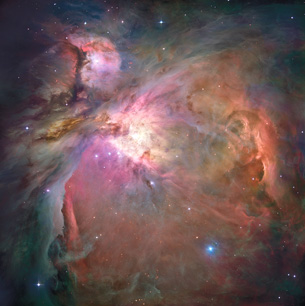Module 5
1. Module 5
1.10. Page 3
Module 5—Wave Theory of Light
 Reflect and Connect
Reflect and Connect

NASA, ESA, M. Robberto (Space Telescope Science Institute/ESA) and the Hubble Space Telescope Orion Treasury Project Team
When you look at the night sky, you are witnessing history. In essence, astronomy is all about ancient history. When you look at the Moon, you are seeing it as it existed 1.3 seconds in the past. Light from the Sun has to travel for eight minutes to reach Earth, so when you look at the Sun you are seeing what it really looked like eight minutes in the past.
The following table shows how old some of the images in the night sky are.
Object |
Time for the Light to Reach Earth |
Moon |
1.3 seconds |
Sun |
8 minutes |
Jupiter |
35–52 minutes (depending on orbital positions) |
Pluto |
5.5 hours (average) |
Alpha Centauri (nearest star system) |
4.3 years |
Sirius (brightest star in our sky) |
9 years |
Betelgeuse (bright star) |
430 years |
Orion Nebula |
1500 years |
Andromeda Galaxy |
2.5 million years |
According to this table, the universe is so vast that common units, such as the metre, would be awkward for describing the distance between Earth and even our nearest neighbouring star system, Alpha Centauri. In such cases, distance is reported in terms of time—as in the light year. For example, the Orion Nebula, as seen in the photo, is 1500 light years away from Earth. One light year is equivalent to the distance that light can travel through a vacuum in a one-year time interval.
1 light year = 299 792 458 m/s × 60 s/min × 60 min/hr × 24 hr/day × 365.25 days/yr
![]()
1 light year = 9.460 730 × 1015 m
Looking at more distant objects, such as the Andromeda Galaxy, reveals the nature of the universe as it existed many millions of years ago. Understanding the speed of light allows you to investigate and understand the nature and history of our universe.
 Module 5: Lesson 2 Assignment
Module 5: Lesson 2 Assignment
Remember to submit the Module 5: Lesson 2 Assignment to your teacher.